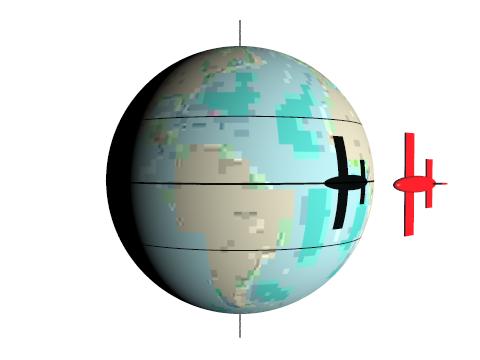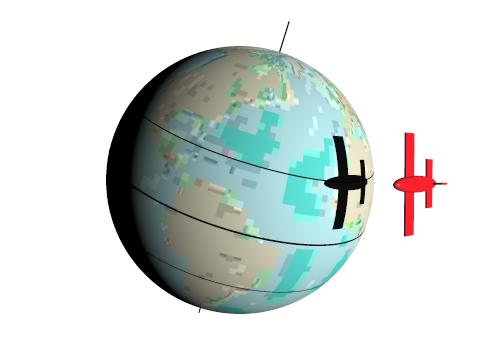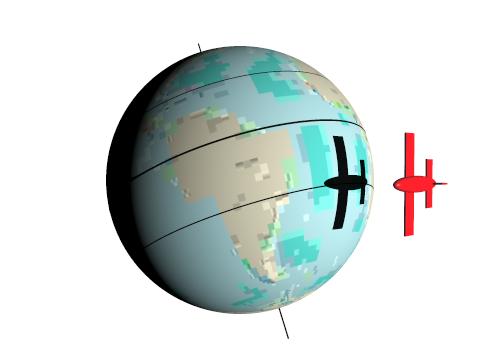
| MadSci Network: Astronomy |
I would like to know how fast I would have to travel if I were 10 miles above the earth's surface and wanted to stay in alignment with the sun, virtually having the earth rotate under me.
We assume that the plane can maintain an altitude of 10 miles and never run out of fuel or have engine problems.
The short answer is: Figure out how fast the surface of the Earth is moving and move that same speed in the opposite direction.
However, if your goal is to stay beneath the sun, then things get more complicated. For one thing, it depends on what time of the year you're flying. As the Earth moves around the Sun, the tilt of the Earth makes the Sun appear to change position in the sky from season to season.
During equinox seasons, Spring and Fall, the orientation of the Earth puts the Sun directly overhead at noon anywhere along the equator. [The word equinox means "equal night" or the amount of daytime and nighttime are equal. This occurs when the Sun "crosses" the equator on March 21st (the "vernal" or Spring equinox) and September 23rd (the "autumnal" or Fall equinox) every year.] During this time, your flight plan will take you along the equator. The radius of the Earth at the equator (remember that the Earth is not a perfect sphere) is about 3963 miles. (See Earth Circumference Calculations.)
The circumference of the Earth at a specific latitude, C, is
C = 2*pi*R*cos(a), where R is the
radius of the Earth, pi = 3.14159..., and a is the
latitude (which is 0 at the equator).
For the equator, the circumference is 24901 miles. This is the distance a point on the equator travels in one day as the Earth rotates on its axis from west to east.
Since you are 10 miles up, you would have to travel 24963 miles in
one day along the equator toward the west. That's more than 1040
miles per hour!

But here is where it gets complicated. During the Summer solstice for the northern hemisphere (June 22), the sun is directly overhead at noon along all points on the circle known as the Tropic of Cancer. (The word tropic comes from Latin and Greek words meaning "of the solstice," and the word solstice means "where the Sun stops".) This is at latitude 23.5 degrees North. (Can you guess the angle of the Earth's tilt?)
Using the calculation above with a = 23.5, the circumference at the
latitude of the Tropic of Cancer is about 22835 miles. At 10
miles up, that has you travelling 22892 miles in one day, or almost
954 mph.

Likewise, during the Winter solstice for the northern hemisphere
(December 22), the sun is directly overhead at noon along all
points on the circle known as the Tropic of Capricorn. (I'll leave
it as an exercise for the student to figure out why they are called
"Cancer" and "Capricorn.") This is at latitude 23.5 degrees South.

The circumference of the Tropic of Capricorn is also about 22835 miles. So your speed is the same as during the Summer solstice, i.e., almost 954 mph.
For extra credit points, derive an equation that calcluates your speed as a function of the day of the year. Good luck!
(Trivia question: What do the Arctic and Antarctic Circles represent?)
[Moderator: For reference, the typical cruising altitude of a commercial jet plane is about 6.5 miles or about 10 km. The typical cruising speed is about 500 miles per hour. The supersonic airplane, Concord, can cruise at an altitude of about 10 mi. at a speed of 1300 miles per hour.]
Try the links in the MadSci Library for more information on Astronomy.